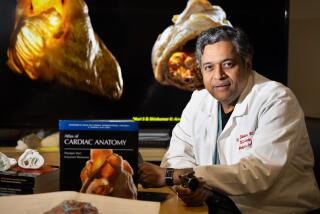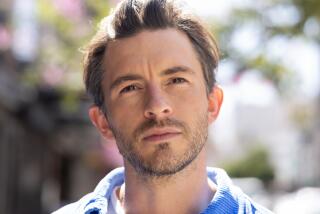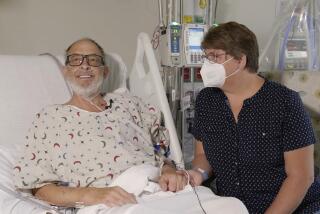Leonard Bailey, surgeon who stoked moral dilemma with baboon-to-human heart transplant, dies at 76
Leonard Bailey, the Loma Linda surgeon who opened new doors in medicine when he transplanted a baboon heart into an infant girl but then endured withering criticism for harvesting an organ from an animal to help save the life of a human, has died after a years-long fight with cancer. He was 76.
Bailey’s decision to transplant the baboon’s walnut-size heart into a 12-day-old infant known only as “Baby Fae” drew international attention and — to some in the medical community — offered a future where there would always be an unlimited supply of animal organs to help save the lives of human patients.
But the moral and ethical questions of using animals as a virtual supermarket for hearts, livers and kidneys were so weighty that cross-species transplants failed to become the norm.
For Bailey, the 1984 surgery established him as a leading authority on heart transplants, a small-town doctor suddenly known internationally as a skilled and daring surgeon. But it all came at a price.
Criticized sharply by animal rights activists who found the surgery to be ghoulish, Bailey was heckled when he spoke publicly. In 1985, Loma Linda officials suggested that he wear a bulletproof vest when he delivered a talk on the ethics of the Baby Fae operation. He canceled his appearance instead.
Even Dr. Christiaan Barnard, the South African surgeon who rewrote the medical rule book with the world’s first heart transplant, wondered whether the Baby Fae transplant had gone too far.
“I used a baboon once, and then a chimpanzee and it was a traumatic emotional experience,” he said in a 1987 interview with The Times. “I am not in favor of using the higher forms like the chimpanzee. Not the apes, they are pretty human, and the bigger ones are already in danger of becoming extinct.”
Bailey was diagnosed with cancer in 2001 and chose to make his condition public, often seeming more curious than worried as it slowly advanced from his tongue to the rest of his body. He died May 12.
Baby Fae weighed all of 4.6 pounds when doctors determined she would likely die from hypoplastic left heart syndrome — a congenital heart defect that defied reconstructive surgery.
Because there were no infant human hearts immediately available, Bailey decided on a radical course — take the heart of a primate, in this case a baboon named Goobers. Though the child died 21 days later, the surgery was seen as a pioneering step in medicine and infant-to-infant heart transplants became an accepted procedure.
“When we operate on these babies, the hope is that they will live longer than us,” Bailey said in 2017 during a reunion with former transplant patients. “It’s nice to know that’s playing out.”
Baby Fae’s parents were a divorced couple from Beaumont, Calif., who came back together to support their daughter’s surgery. Never identified beyond their first names — Teresa and Howard — they backed Bailey’s decision to use a heart from a primate to save, or at least extend, their daughter’s life.
“There are a lot of sentimental ways of talking about the heart, but it’s really just a pump,” the mother told People magazine in their only interview. “The soul is not in the heart. The soul is in the brain.”
Leonard Lee Bailey was born Aug. 28, 1942, in Takoma Park, Md. His father was a professional chef and his parents encouraged Bailey to dream big. He graduated from Columbia Union College — now Washington Adventist University — and later earned a medical degree from Loma Linda University of Medicine in San Bernardino County.
Bailey did his residency at Toronto’s Hospital for Sick Children, where he was pained while he watched as otherwise healthy babies died from congenital heart defects. He joined the faculty at Loma Linda University in 1976 as an assistant professor at the School of Medicine.
“In those days,” he said in a 2009 interview, “the advice to parents was to leave the baby here to die or take it home to die.”
The Baby Fae transplant was transformative to Loma Linda, located 60 miles from downtown L.A. and then a world away from the elite medical universities. But with Bailey’s help, and his growing list of successful heart transplants, the university hospital became recognized as a world-class pediatric heart transplant center.
During his time there, Bailey performed 375 infant heart transplants, including the first infant-to-infant heart transplant. As his young patients grew older, they often returned to campus to visit him. With his encouragement, one went to medical school.
Later in life, he pondered the legacy of the Baby Fae surgery. If he were able to perform it again, he said, he would have preferred to use a human heart. At the time though, he told The Times, none was available and time was running out for the little girl.
Bailey also described what he called his “catastrophic” decision to use the heart of a baboon that had a different blood type than the infant girl. The child was type O, the baboon AB.
“If Baby Fae had the type AB blood group,” he told medical officials at a conference, “she would still be alive today.”
Bailey is survived by his two sons, Brooks and Connor. His wife, Nancy, a Loma Linda graduate, died in April.
More to Read
Start your day right
Sign up for Essential California for the L.A. Times biggest news, features and recommendations in your inbox six days a week.
You may occasionally receive promotional content from the Los Angeles Times.







